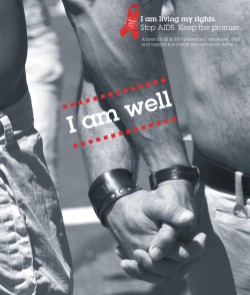Human rights monitor
Breaking through the silence: HIV
and the deaf
 This week, different groups around the world are observing World AIDS Day and the International Day of Persons with Disabilities, on December 1 and 3 respectively. Rarely have the two been observed together. At least until this year. Events hosted at UN headquarters in New York and the US State Department are drawing attention to the strong link between disability and HIV.
This week, different groups around the world are observing World AIDS Day and the International Day of Persons with Disabilities, on December 1 and 3 respectively. Rarely have the two been observed together. At least until this year. Events hosted at UN headquarters in New York and the US State Department are drawing attention to the strong link between disability and HIV.
Here are the facts: Persons with disabilities have the same types of sexual relationships and frequency of sexual activity as persons without disabilities. Individuals with disabilities sometimes use drugs or visit or work as sex workers. According to the World Bank, persons with disabilities may be more vulnerable to HIV because they are more likely to be abused, marginalized, discriminated against, illiterate, and poor. Women with disabilities are up to three times as likely to be victims of sexual violence.
But many of the stories of people with disabilities and their experiences with HIV - particularly those who are deaf - are shrouded in silence.
Take the story of John Meletse in South Africa. He went to the local clinic to get an HIV test. They had no sign language interpreter and referred him to another doctor. This doctor did not know sign language either, but communicated with hand-written notes. The doctor administered the test without any counselling. Fifteen minutes later, the doctor wrote in big bold letters: "YOU ARE HIV POSITIVE." John asked if this was really true. The doctor replied, "Yes, and you can go now."
Imagine the experience of Erica, an HIV-positive deaf woman in Uganda. She was not aware that she was having twins when she went into labour. The nurse did not know sign language and did not tell her to keep pushing after she gave birth to her first child. Erica subsequently lost the second twin. It is not clear if she ever received information about mother-to-child transmission of HIV. Erica's children are beaten by her neighbours. When they played with the neighbours' children, they were told to go away. They said, "You'll spread deafness to my family."
Or Jane, who fled her village in northern Uganda as a result of raids by the Lord's Resistance Army. She is hard of hearing and was never able to go to school. In her words, "I fear HIV so I don't move around." This fear is also why she stays with her husband, who physically and sexually abuses her. Jane has not benefited from any community HIV programs because she hasn't been able to find out about them.
Consider the barriers preventing persons who are deaf or hard of hearing from receiving HIV information and care. Radio programs, a common part of public awareness campaigns, completely exclude persons who are deaf or hard of hearing. Printed material alone is clearly not sufficient. Sign language interpretation and presentations are key, but they are rare, especially in the developing world.
An estimated 90 percent of deaf people in developing countries cannot read or use formal sign language. Instead, deaf people in developing countries often communicate with local signs or family-specific gestures. This makes medical settings especially problematic because they must bring a close family member along to communicate for them. When dealing with sensitive or stigmatised topics, such as sexual assault or HIV testing, the lack of confidentiality often dissuades people from revealing their concerns. Stigma in the community and myths that people with disabilities are asexual or virgins further isolate them from HIV information, testing, counselling, and other services.
Because of communication barriers, lack of education, ignorance and fear, deaf people around the world are overlooked by HIV services. UNAIDS and the US State Department are taking a first step at addressing this gap by getting policymakers to think about how to make HIV strategic plans, programs and services inclusive to people with all types of disabilities.
Much more needs to be done, though, particularly on the national level. Basic sign language and disability awareness training for health workers is absolutely fundamental to stopping the spread of HIV among people who are deaf. In addition, governments need to ensure that children who are deaf or hard of hearing are able to attend schools to learn sign language and about health topics such as HIV.
Without a concerted effort to reach out to the deaf population, they will continue to live in silence and fear, and the HIV epidemic will quietly continue to spread.
Source: Human Rights Watch.